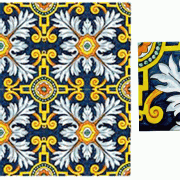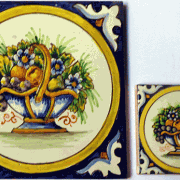TILES - Reproduction of a design (IN CONSTRUCTION)
Reproduction of tile designs. If you have to reproduce antique tiles that are going to replace one or two broken ones in a large wall design, to get an exact likeness is very difficult because many of the methods of working have change. Lead that was in glazes and colors is now illegal to use, it is dangerous to touch or inhale. The method of firing was with wood now it is electricity or gas and the way of making tiles has changed, most are industrially made but they can still be bought hand made. A potter once did everything, from taking the earth out of the ground to selling his work in the streets.
One of the problems is that many old designs have been copied and printed industrially. The buildings they are in can be 300 years old but the tiles are modern and printed and the person in charge of restoring knows nothing about tiles and informs some poor house owner he cannot change the tiles, he must get reproduction of the same design.
To copy an industrial printed tile is impossible because the firms are interested in printing thousands and your client wants 50 so the only way to do it is with transfers. When printed the designs and color are flat and each one is exactly the same they have not got the individual touch that hand painted work has.
Most of the old tiles were painted with the in-glaze method (Majolica). There are different ways and styles of decorating with this method but the basic way of working does not change. Clay that has been bisque fired is covered by an opaque glaze-base, it is decorated with colors mixed with a transparent glaze and the two are fired together at 980º C. The methods use in the past were mainly, stenciling and hand painting, two different ways of applying colors.
a) Stenciling is to cut out spaces in prepared paper, to form a pattern, it is laid on top of tile and with a large brush the space is cover with a color. The colors are flat and the lines, created by the hair of the brush, can be seen and round the edge of the part stenciled the color is thicker.
b) With hand painting you see the movements of the brush-stroke and the different density of a color and the ones that overlap to form shading and other colors.
If you are in the situation where you have a reproduction of an antique tile, first make sure they are antique. Send us a good photo, its measurements and anything you think might be important.
The following photos show the three different way of reproducing designs – a), b) & c) hand painted tiles. / d), e) & f) stenciling. / g), h) & i) transfers.









